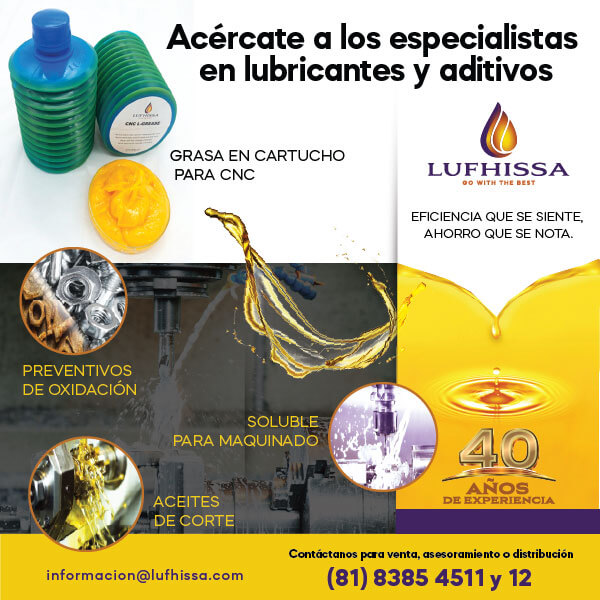MEXICO: 1ST PLACE IN EXPORTS OF ELECTRICAL APPLIANCES AND BLACKBERRY
The country also stands out for receiving second place in exports of refrigerators and flat-screen TVs, as well as third place in cell phones as a whole and fifth in automobiles
In 2010, the country’s total exports reached 257.9 billion dollars.
“During the first half of 2011, the country has already exported 57% of the total quantity of products exported in 2010. That is to say: if we continue to export at this same rate during the second half of this year, we could be exporting close to 350 billion dollars’ worth of products by the end of 2011,” remarked Juan Manuel Quiroga, Executive Director of the Northeast Mexico Council on Foreign Trade (in Spanish, COMCE Noreste).
In 2010, notable exports were made by several states, including Nuevo León, whose exports amounted to 24.7 billion dollars and accounted for 8.6% of the country’s total exports.
Last year, Tamaulipas’ exports reached 25.1 billion dollars, Coahuila’s 14.8 billion dollars, Querétaro’s 3.5 billion dollars, Guanajuato’s nearly 3.2 billion dollars, and San Luis Potosi’s 3 billion dollars.
Between 2008 and 2010, a total of 17 Mexican products, which make up more than 50% of the country’s exports to the United States, increased their share to that market. ?
Given the above, Mexican exports to its NAFTA partners make it the principal Latin American trading partner to the U.S. and Canada, and also exceed Japanese and Indian exports to these countries.
At the global level, Mexico topped last year’s list of exporters of household appliances and BlackBerry phones, was second in the list of those exporting refrigerators and flat screen TVs, and the third-largest exporter of cell phones in general, surpassed in this last category by only China and South Korea.
In terms of agricultural products, the country remains the world’s top exporter of tomatoes, avocadoes, onions, papayas, eggplant and peppers. ?
Since Mexico’s entry into the North American Free Trade Agreement (NAFTA) in 1994, its exports of food products to Canada have increased by 555 percent, reaching over 1 billion dollars last year.
In fact, in 2010, Mexico was ranked as the second leading exporter of food products to Canada, growing 27.4% from January to November 2010, second only to the United States in this area.
2011: A Successful Year
From January to June 2011, exports grew about 21% as compared with 2010.
In 2010, Mexico was the U.S.’s second leading supplier of non-petroleum products. During the first half of 2011, these have accounted for 83% of its exports.
These exports include those made by agribusiness, mining, and manufacturing.
"79% of these exports are made by the manufacturing industry. The important thing is to see how they move, and it is noteworthy that they grew 17% as compared to the 21% of total exportation growth," said Quiroga.
From January to May 2011. The core of Mexican exports is concentrated in only one manufacturing sector – that of metal products, machinery and equipment – which reflects 72% of total exports.
The aforementioned sector consists of three sub-sectors: automotive products, general machinery and equipment, and electronics, electrical equipment and appliances.
"It’s here where the country's exports are focused. These three areas alone make up a total of 72.3 billion dollars of our exports. That is, they account for 64% of the total 72% that industry brings in,” explained COMCE Noreste’s leader.
Companies based in automobiles, automotive parts, electrical equipment, electronics, aerospace and machinery for agricultural industries stand out for their exports, especially foreign-owned companies.
In the area of non-petroleum products, Mexico grew in 2010 to become the United States’ second foremost supplier, surpassed only by China, after it registered a 60% growth as compared to 2009 and reached a record participation in that market of almost 13%. ?
As for the balance of trade, which subtracts imports from exports, the first half of this year showed a surplus; that is, during this period, the country exported more than it imported, for a total of over 3.3 billion dollars.
"Last year, Mexico ended the year with a negative 3.009, i.e., it imported more than it exported," said the organization’s manager.
Stimulating the economy
To encourage trade after the economic crisis of 2009, Mexico reduced tariffs from an average of 13 percent to a little over four percent, effective starting on January 1, 2011. This reduction favored the importation of raw materials to be used for products that would later be exported. Thus, Mexico was ranked as one of the most efficient and competitive countries in a variety of industrial sectors, including that of articles manufactured expressly for exportation to the United States and Canada.
Automotive Exports
In 2010, the Mexican automotive industry stood out due to its strong exports, reaching a record level of 1.8 million units exported out of the over 2.3 million units produced on an annual basis. Therefore, it is ranked as the fifth largest automotive exporter in the world, representing 25% of these activities in the manufacturing sector.
More specifically, four out of every five vehicles produced in Mexico were exported. This places it among the most important auto exporters worldwide, exceeded only by Japan, Germany, South Korea, and Spain.
Likewise, Mexico is the world’s ninth largest auto manufacturer,
Nuevo Leon and Coahuila
Nuevo Leon is the state with the fifth highest number of exports in the country. The Federal District is the top exporting state, not because it is home to much manufacturing, but because many corporate headquarters are registered there.
Second place in exporting belongs to North Baja California, particularly due to the number of maquiladoras (factories) located there, the same as in Chihuahua and Tamaulipas.
In 2010, exports in Nuevo Leon rose to 24.7 billion dollars, representing 8.6% of the country’s total exports.
"Nuevo Leon is a very diversified state, because it has a variety of production and a ready and wide export base," said Edmundo Gonzalez, Director of ProMéxico’s Northeast Zone.
He specified that 80% of exports were destined for the United States, while 4% were headed to Canada, and 1% each to Colombia, Brazil and China. The rest of its exports are divided among a wide range of countries.
In Nuevo León, it is worth noting the exports made by large manufacturers of auto parts, steel and electronic equipment, such as phones and computers.
From January to April 2011, ten companies in Nuevo León stood out because of their exports: Celestica, Navistar, Nemak, DeAcero, Ternium, Kemet, Lenovo, Carrier, LG and John Deere.
"The aforementioned companies account for 38% of the state’s exports, so they are hugely important," said Quiroga, who stressed that, if these companies keep passing gains made during this first fourth-month period, exports could be expected to be close to 12 billion dollars by the end 2011.
"In the first four months of the year, these ten companies have already sent out 42% of what they exported in 2010," emphasized Quiroga.
Alternatively, Coahuila stands out for its exportation of auto parts such as the chassis, harness, and other general parts, as well as of electrical appliances and of mining and metallurgical byproducts.
In 2010, Coahuila exported 12.7 billion dollars’ worth of products.
The United States is Mexico’s main exporting destination. Nuevo León and Coahuila are especially heavy exporters because of their proximity to the border.
"The United States remains Mexico’s main destination for exports. 78% of Coahuila’s exports are headed there, as opposed to the 6% that it sends to the UK, 3% to Switzerland, 3% to Canada, and the rest to various countries," said Gonzalez.
Exports in Querétaro
Nationally, Querétaro has established itself as one of the best states in terms of per-capita-rate export growth. It has obtained significant numbers of exports starting from four million dollars on up, explained Samuel Lara, the State of Querétero’s Director of Export Promotion. Lara also mentioned that 2010 total exports were nearly 4 billion, which represents just over 1% of national exports. This year the figure is expected to increase from 15 to 20 percent.
First and foremost, Queretero’s principal export sector is that of auto parts, which accounts for more than 35% of the state’s total exports. The state has no auto assembly plants.
In second place is the aerospace sector. This sector has become more important ever since, over six years ago, the Bombardier Company established in Querétaro more than 50 related companies, allowing the state to increase exports by more than 500 million dollars.
In third place comes the electrical manufacturing industry, in which major multinational companies like Siemens export significant quantities of products, at a similar rate to that of the aerospace sector.
The fourth sector belongs to the metal mechanics industry because a large number of companies offer services in metal mechanic processing, such as casting and machining. Many of their products are directly exported to the United States.
Another major category in exports is the appliance industry. About five major companies are big exporters worldwide, including the Mexican company Mabe, Samsung, Daewoo, and LG. Another important sector is that of food and beverages, due to the presence of transnational corporations like Kellogg's and Nestlé.
Some of Querétero’s main exports come from the auto parts sector: air bags, gear boxes, and steering wheels, as well as aerospace products: wings, harnesses, steel structures, plane assembly parts, landing gear, braking mechanisms, disk brakes, cereals, jeans, and so on.
"The principal country to which we export is the United States, which is our main export market for sectors like auto parts, aerospace, engineering, and others. These sectors represent more than 70% of Querétero’s exports to the U.S. market. Canada follows with 9% of our exports, or 360 million dollars. In total, North America is our main export market with nearly 80% of all exports, "said Lara.
According to the Director, Querétaro is a major exporter to South America, where 7.3% of its exports go; Europe, with 5.6% of its exports; Asia, with 3%; and Central America and the Caribbean, also with 3%.
It should be noted that other major countries are also recipients of the state's exports, including Brazil, Japan, Colombia, Germany, France and Guatemala.
Award Winning
In order to recognize companies that export products, COMCE Noreste awards the Merit Exporter Award once every two years.
In 2011, Sagui International was awarded the prize in the category of small manufacturing industry, just as it was in 2005.
Similarly, Blackhawk Mexico received the prize in the medium manufacturing category, as did Lego Operations of Mexico in the large manufacturing category.
In order to be awarded the abovementioned recognition, companies must meet different criteria, such as excellent performance in exportation, promotion, and technological development; international marketing and promotion; export strategy and organization and development.
Table
2010 Exports (averages in billions of dollars)
Nuevo León 24.7
Tamaulipas 25.1
Coahuila 14.8
Querétaro 3.5
Guanajuato 3.2
San Luis Potosí 3.0
Sources: Banco de México, INEGI and Data Nuevo León.










































































































































































